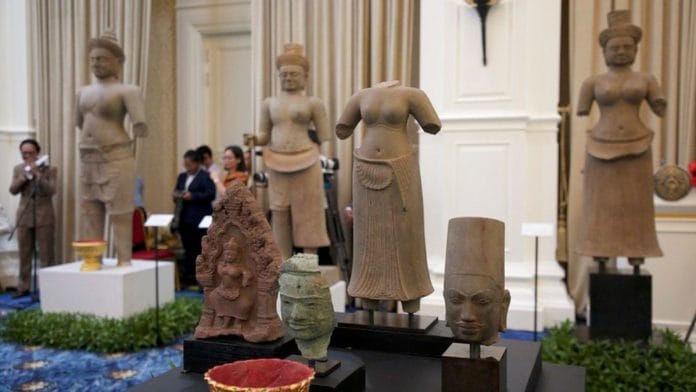New Delhi: Cambodia’s Prime Minister Hun Manet led a celebration Thursday to mark the repatriation to the country of 14 sculptures of Khmer cultural significance, from the United States last week.
The sculptures have now been put on display at the Peace Palace (PM’s office in Phnom Penh) among 70 others repatriated from the US over the years. All pieces are from the ninth century to 14th century (Angkor) period—significant to Hindus and Buddhists.
Among the 14 sculptures repatriated last week are a stone sculpture of the Hindu diety, Uma, also known as Parvati; a 10th-century bronze head of the Buddhist deity, Avalokiteshvara; and other stone sculptures of Shiva, Ardhanarishvara, and warriors featured in Mahabharata.
The 70 repatriated pieces are traceable to the Khmer Empire, founded by the Hindu king Jayavarman II.
Prime Minister Manet described the return of the pieces as a moment to reconnect the people of Cambodia with their “ancestral souls”.
“It’s not just the everyday people who seek peace; divine families, as well, wish to reunite with the spirits of their ancestors. Without maintaining peace, we cannot fully reclaim the rich history and heritage that belongs to Cambodia,” he said during celebrations Thursday.
The 70 pieces were sourced from New York’s Metropolitan Museum of Art (Met) and other private collectors over the years.
According to the Cambodian government, the pieces were looted in the 1970s when the country was under the rule of the Khmer Rouge. A long civil war and instability marked those years.
The suspicion is that Douglas Latchford—an art dealer indicted in 2019—trafficked the pieces. After an investigation against Latchford, the Met agreed to repatriate 14 pieces to Cambodia and two to Thailand in 2023. Latchford had passed away in 2020.
According to Cambodia’s Ministry of Culture and Fine Arts, “A total of 70 Khmer cultural objects have been returned through a range of different processes, including voluntary returns, negotiations, seizures and legal proceedings, from different collections such as from the Lindemann family, Jim Clark, the Metropolitan Museum of Art in New York, and other private collectors in the United States.”
The return of the pieces followed several years of negotiations between various US federal agencies and teams of Cambodian officials. The pieces join the over 1,000 artefacts that Cambodia has repatriated from over 15 nations, including France, Britain, France, Japan, Thailand, and Indonesia, among others, since 1996.
Cambodia Culture Minister Phoeurng Sackona said the return of the objects is significant “for recalling the heritage of their ancestors through good times and bad”.
“These returns contribute to the reconciliation and healing of the Cambodian people, who endured decades of civil war and suffered tremendously from the tragedy of the Khmer Rouge regime,” Sackona added.
Now, Cambodia hopes to receive 50 more pieces from the US.
Cambodia is the latest country to benefit from a trend of repatriation of art pieces that carry cultural significance.
In April this year, the United Kingdom returned 32 gold and silver treasures—stolen during British colonial rule in Ghana nearly 150 years ago—to the West African country but on the receipt of a loan.
And in July this year, after a year-long negotiation, the Ministry of Culture of India and the United States signed the first-ever ‘Cultural Property Agreement’ to prevent the trafficking of cultural property and return of antiques to their place of origin.
Around the same time, Fowler Museum at the University of California, Los Angeles, repatriated 20 objects to the Warumungu people of Australia.
(Edited by Madhurita Goswami)
Also read: How India-US agreement for stolen art can help nab ‘small-ticket items’, tackle smuggling at borders







Had it so happened in India, several opposition political parties would have raised much hue and cry?